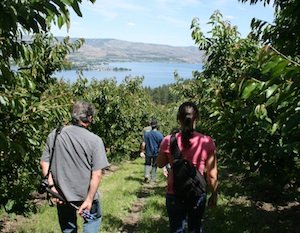
The tour visited the lakeside orchard of Ray Fuller at Chelan, who has been farming organically for almost 30 years. With its steep slopes, the orchard does not lend itself to mass production.
Many of the discussions focused on how organic fruit production practices are being adopted by conventional growers, with the two production systems becoming less distinct.
Participants visited three orchardists growing organic tree fruits on different scales in north central Washington: Mike Brownfield, who has a 50-acre diversified orchard at Chelan; Ray Fuller, who has about 125 acres of apples, pears, and cherries, overlooking Lake Chelan; and Kyle Mathison, who grows 1,000 acres of cherries—a third of them organic—along with 200 acres of organic apples and pears. Mathison uses many of the same production practices, such as applying compost and compost tea, on his organic and conventional blocks.
During the meeting, organic retail consultant Don Harris reported that the market for organic produce is growing at 9 percent annually—more than twice the rate of conventional produce—and the number of organic items on sale has tripled in the last five years.
But there’s still plenty of room for growth. Globally, only 0.64 million hectares out of the 55.6 million hectares of fruit grown worldwide are organic, reported David Granatstein, sustainable agriculture specialist for Washington State University’s Center for Sustaining Agriculture and Natural Resources, one of the organizers of the event.
Organic apples represent only 1 percent of the total world apple supply.
Statistics show that more than half of the world’s organic fruit acreage is in Europe, though there are no data from China or India. Latin America has 24 percent of the world’s total fruit acreage, and North America only 7 percent.
Italy, Spain, and France are the top three organic fruit producers. The top organic fruits are grapes, bananas, and apples. Poland more than doubled its organic apple production in the last five years.
Watch for more detailed reports on the symposium in upcoming issues of Good Fruit Grower magazine.

Leave A Comment